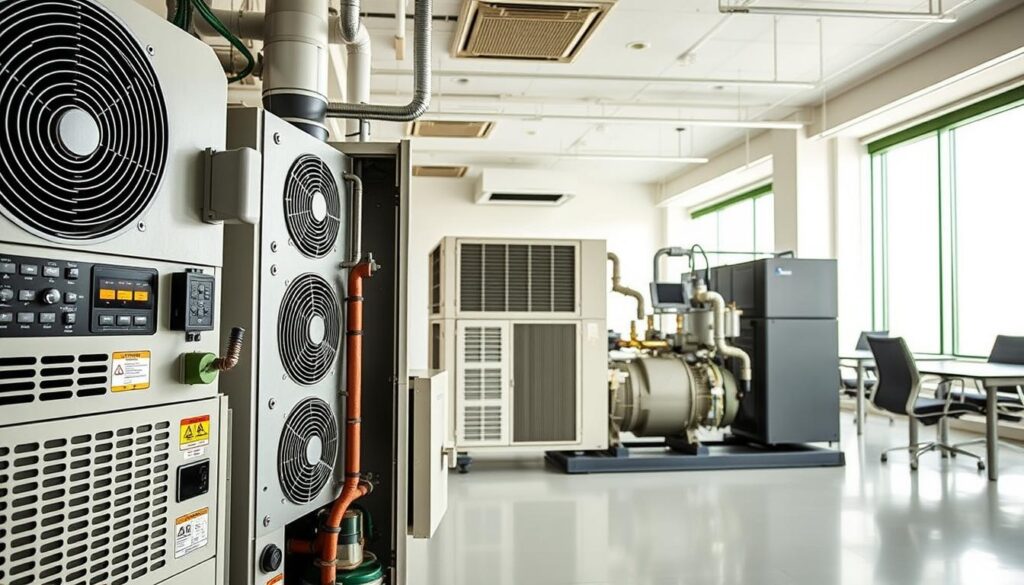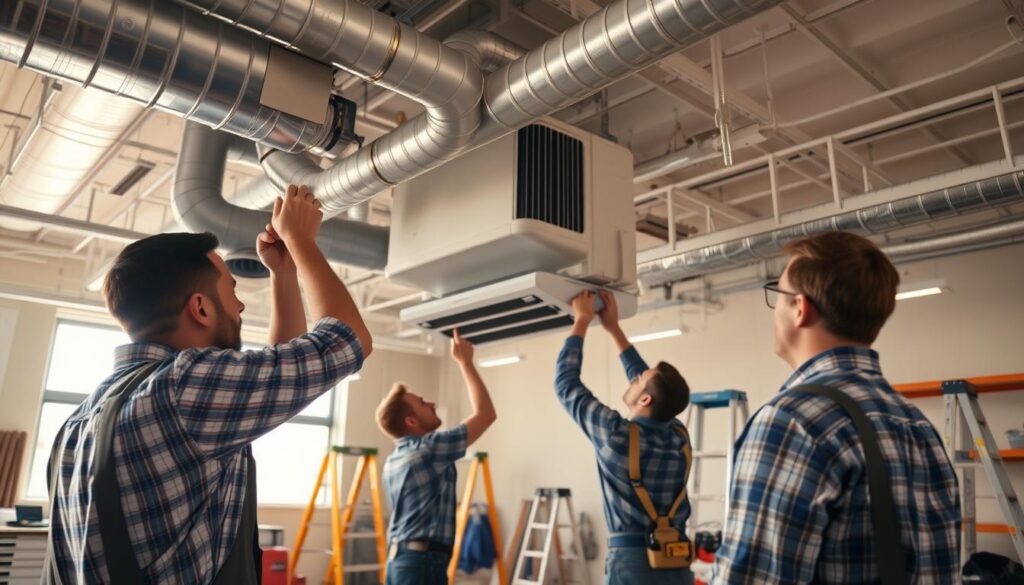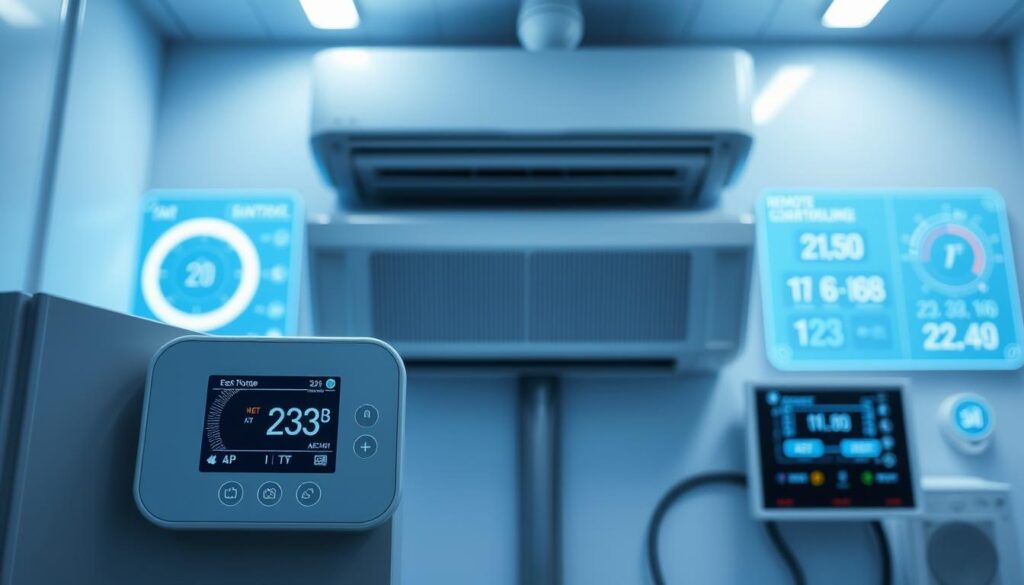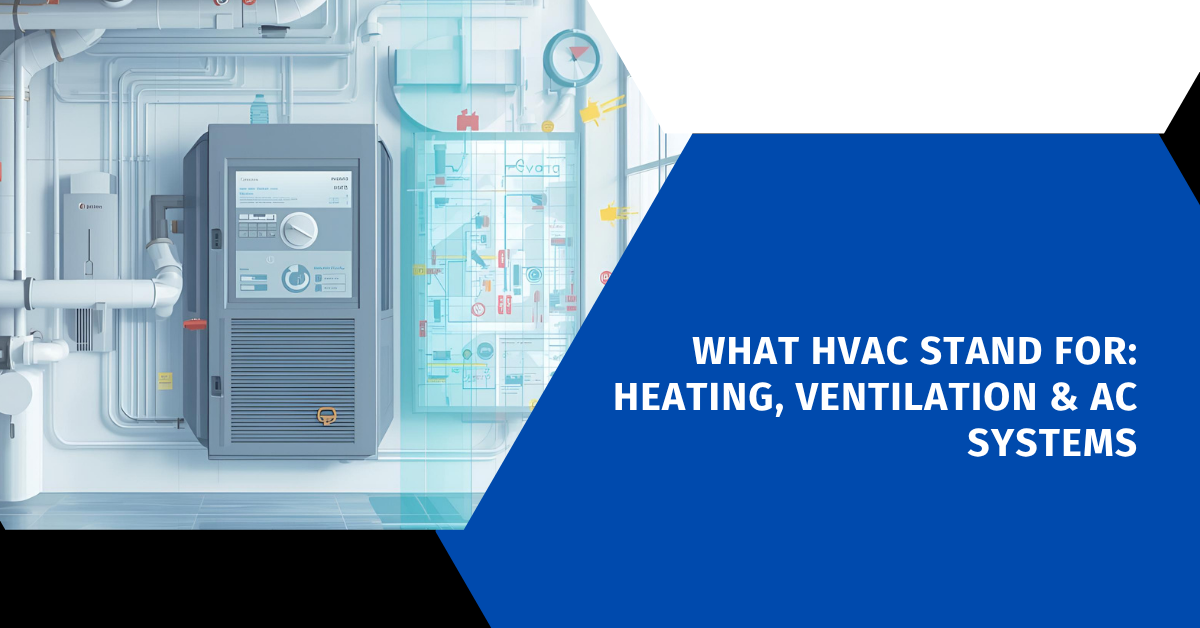Affiliate Disclosure
HVAC Guide Guys is a participant in the Amazon Services LLC Associates Program, an affiliate advertising program designed to provide a means for sites to earn advertising fees by advertising and linking to Amazon.
What HVAC Stand For? Ever wondered how your home stays comfy in hot summers and cold winters? It’s all thanks to HVAC. This system is key to making your living and work spaces better.

HVAC is more than just controlling the temperature. It’s about keeping the air inside your home clean and comfortable. When we talk about HVAC, we’re discussing a network of technologies that make your indoor space perfect.
Today’s buildings need HVAC systems to keep the temperature right, clean the air, and move it around. These systems are vital in homes and big buildings. They help make places where people can feel at ease and stay healthy.
Key Takeaways
- HVAC stands for Heating, Ventilation, and Air Conditioning
- These systems control indoor temperature and air quality
- Essential for comfort in residential and commercial spaces
- Involves complex technologies beyond simple temperature management
- Critical for maintaining healthy indoor environments
Table of Contents
Understanding What HVAC Stand For
HVAC stands for a system that makes your indoor space comfortable and healthy. It combines heating, ventilation, and air conditioning. Together, they create the ideal climate for homes, offices, and industrial areas.
- Heating: Provides warmth during cold seasons
- Ventilation: Circulates fresh air and removes contaminants
- Air Conditioning: Cools and dehumidifies indoor spaces
Breaking Down the HVAC Acronym
Each part of the HVAC system has its own role in keeping you comfortable. It ensures you breathe clean air and stay at the perfect temperature all year.
“Comfort is not just about temperature, but about creating the right environmental conditions.” – HVAC Expert
History and Evolution of HVAC Systems
The history of HVAC technology started with pioneers like Willis Carrier and Alfred Wolff. The first modern air conditioning system was made in 1902 for the New York Stock Exchange. This was a big step in controlling temperature.
The Role of Modern HVAC Technology
Today’s HVAC systems are advanced and save energy. They do more than just control temperature. They also improve air quality, cut down energy use, and use smart tech for better performance.
- Smart thermostats for precise temperature control
- Energy management systems
- Advanced air purification technologies
Explore Our HVAC Shop
Looking for top-rated HVAC tools, parts, and accessories? Visit our shop and find the perfect solution for your needs.
Visit the ShopCore Components of HVAC Systems
Understanding HVAC systems is key to knowing how they keep us comfortable indoors. The hvac acronym meaning is more than just controlling temperature. It involves a complex network of equipment that manages air quality and environmental conditions.
Modern HVAC systems are complex networks of specialized equipment. They work together to create the best indoor environments. When you explore what does hvac mean, you’ll see a detailed approach to heating, cooling, and ventilation.
Heating Components and Mechanisms
Heating elements are the first part of HVAC terminology. These systems include:
- Furnaces using gas or electric power
- Heat pump systems
- Radiant floor heating technologies
- Boilers for water-based heating
Ventilation Equipment and Air Distribution
Ventilation is key to keeping indoor air quality good. Important ventilation components are:
- Air handlers
- Ductwork systems
- Air filtration mechanisms
- Exhaust fans
Air Conditioning Units and Cooling Functions
Air conditioning units are the last important part of HVAC systems. These machines control indoor temperature through:
- Refrigeration cycles
- Compressor technologies
- Thermal exchange mechanisms
- Humidity control systems
Each part works together to control the environment. They turn raw energy into comfortable, clean indoor spaces.
How HVAC Systems Work Together
Learning about HVAC basics means understanding how each part works together. Your HVAC system is like a team that keeps your indoor space comfortable. Each part is key to managing temperature and air quality.
Your thermostat is the system’s brain. It checks the room’s temperature and makes changes to keep you comfy. If the temperature changes, it sends signals to other parts of the system.
- The heating unit kicks in when it gets too cold
- Air conditioning turns on when it’s too warm
- Ventilation systems keep air moving and clean
In simple terms, each part of the HVAC system works together. Your furnace or heat pump makes warm air. At the same time, air conditioners cool and remove humidity. Ventilation systems make sure air is fresh and clean.
This teamwork creates a comfortable indoor climate. It’s important to have the right size and design for your system. This ensures energy efficiency and comfort in your home or office.
Effective HVAC systems are about precision, synchronization, and intelligent environmental management.
Types of HVAC Systems for Different Applications
Understanding HVAC is more than just knowing about heating, ventilation, and air conditioning. Different places need special HVAC systems. These systems are made for specific needs, building types, and how they work.
There are many types of HVAC solutions for different uses. Each one has its own design needs:
- Residential systems focused on home comfort
- Commercial installations for professional environments
- Industrial applications with complex thermal management
Residential HVAC Solutions
Home HVAC systems are usually small and efficient. Homeowners can choose from:
- Split systems with separate indoor and outdoor units
- Ductless mini-split systems for flexible zoning
- Packaged HVAC units ideal for smaller spaces
Commercial HVAC Installations
Commercial spaces need strong HVAC systems. These systems handle bigger areas and many people. They focus on keeping temperatures steady, air clean, and using less energy.
“The right HVAC system transforms commercial environments into comfortable, productive spaces.” – HVAC Engineering Professionals
Industrial HVAC Applications
Industrial places need special HVAC solutions. These systems must handle tough conditions. Factories need systems that control temperature and humidity well over large areas.
Energy Efficiency in HVAC Systems
Learning about HVAC basics shows how important energy efficiency is. Energy-efficient HVAC systems cut down on environmental harm and lower your utility bills.
Exploring hvac energy efficiency, you’ll find several key ratings:
- AFUE (Annual Fuel Utilization Efficiency)
- HSPF2 (Heating Seasonal Performance Factor)
- SEER2 (Seasonal Energy Efficiency Ratio)
- EER2 (Energy Efficiency Ratio)
Today’s HVAC tech aims to use less energy while working better. ENERGY STAR certified equipment is the top choice for saving money over time.
Here are ways to boost your HVAC’s energy efficiency:
- Install smart thermostats
- Keep your system in good shape
- Choose high-efficiency units
- Use zoned heating and cooling
Choosing energy-efficient HVAC systems cuts down your carbon footprint and saves money. The HVAC world is moving towards greener, smarter tech.
Explore Our HVAC Shop
Looking for top-rated HVAC tools, parts, and accessories? Visit our shop and find the perfect solution for your needs.
Visit the ShopThe Importance of Proper HVAC Installation

Understanding what HVAC stands for—Heating, Ventilation, and Air Conditioning—is key. Your HVAC system is a big investment in your home’s comfort and efficiency.
Installing an HVAC system is more than just putting equipment in place. It needs special knowledge and skills that most people don’t have.
Professional Installation Requirements
Qualified HVAC professionals must meet several key requirements:
- Comprehensive technical training and certification
- Understanding of local building codes
- Advanced diagnostic and measurement skills
- Proper handling of specialized equipment
Common Installation Challenges
Installation can face many challenges that need expert help:
- Precise system sizing for optimal performance
- Correct ductwork design and sealing
- Electrical system compatibility
- Refrigerant charge and line set installation
Safety Considerations
Professional HVAC installers focus on safety by:
- Electrical safety protocols
- Proper refrigerant handling
- Preventing carbon monoxide risks
- Ensuring structural and environmental compliance
Trying to install it yourself can void warranties, pose safety risks, and damage your system over time. Always choose certified professionals for your HVAC needs.
HVAC Maintenance and Care
It’s vital to keep your HVAC system in great shape. Regular upkeep stops sudden breakdowns and keeps energy use down. This approach ensures your system works well for a long time.
Learning about HVAC basics means knowing what maintenance you can do yourself:
- Change air filters every 1-3 months
- Clean outdoor unit from debris quarterly
- Check thermostat settings seasonally
- Inspect air vents for blockages
Don’t forget the importance of professional maintenance. Getting an annual check-up from a certified tech can spot problems early. This saves you from costly repairs later on.
| Maintenance Task | Frequency | Benefit |
|---|---|---|
| Air Filter Replacement | Every 1-3 months | Improved air quality |
| Professional Inspection | Annually | Prevent major system failures |
| Coil Cleaning | Twice per year | Enhanced system efficiency |
Watch for warning signs that indicate your HVAC system needs professional attention:
- Unusual noises during operation
- Inconsistent temperature control
- Increased energy bills
- Weak airflow from vents
By regularly maintaining your HVAC system, you can make it last longer. This ensures your home stays comfortable all the time.
Explore Our HVAC Shop
Looking for top-rated HVAC tools, parts, and accessories? Visit our shop and find the perfect solution for your needs.
Visit the ShopModern HVAC Innovations and Smart Technology
The HVAC world is changing fast, introducing new ways to control our indoor air. Smart tech is making it easier to keep our spaces comfortable.

Today’s HVAC systems are smarter and more user-friendly. They aim to be more efficient and kind to our planet.
Smart Thermostats and Controls
Smart thermostats have changed how we manage our homes’ temperature. They let you:
- Change the temperature from your phone
- Learn your favorite settings
- See how much energy you use
- Work with other smart home devices
Energy Management Systems
Energy management systems are making buildings more efficient. They help by:
- Using less energy
- Knowing when to do maintenance
- Improving HVAC performance
- Lowering costs
Future HVAC Technologies
New tech is changing HVAC systems. Geothermal heating, solar power, and AI for maintenance are leading the way.
These advancements mean better, greener, and smarter ways to control our climate. They adapt to our needs and the environment.
Conclusion
Understanding what HVAC stand for shows how important heating, ventilation, and air conditioning systems are. They keep indoor spaces comfortable, whether it’s your home or a big office building.
Modern HVAC systems do more than just control the temperature. They also improve air quality, save energy, and make spaces more comfortable. Investing in good HVAC systems and getting them installed and maintained by pros is key. This way, you get the most out of your investment.
As technology gets better, HVAC systems are getting smarter and greener. They’re also linking up with home automation more often. Whether you live in a house or manage a building, knowing about these changes helps you make smart choices about your indoor climate.
Don’t forget, HVAC pros are your go-to for advice and help. They can help you pick the best system for your needs. They know how to balance comfort, efficiency, and your specific needs.

